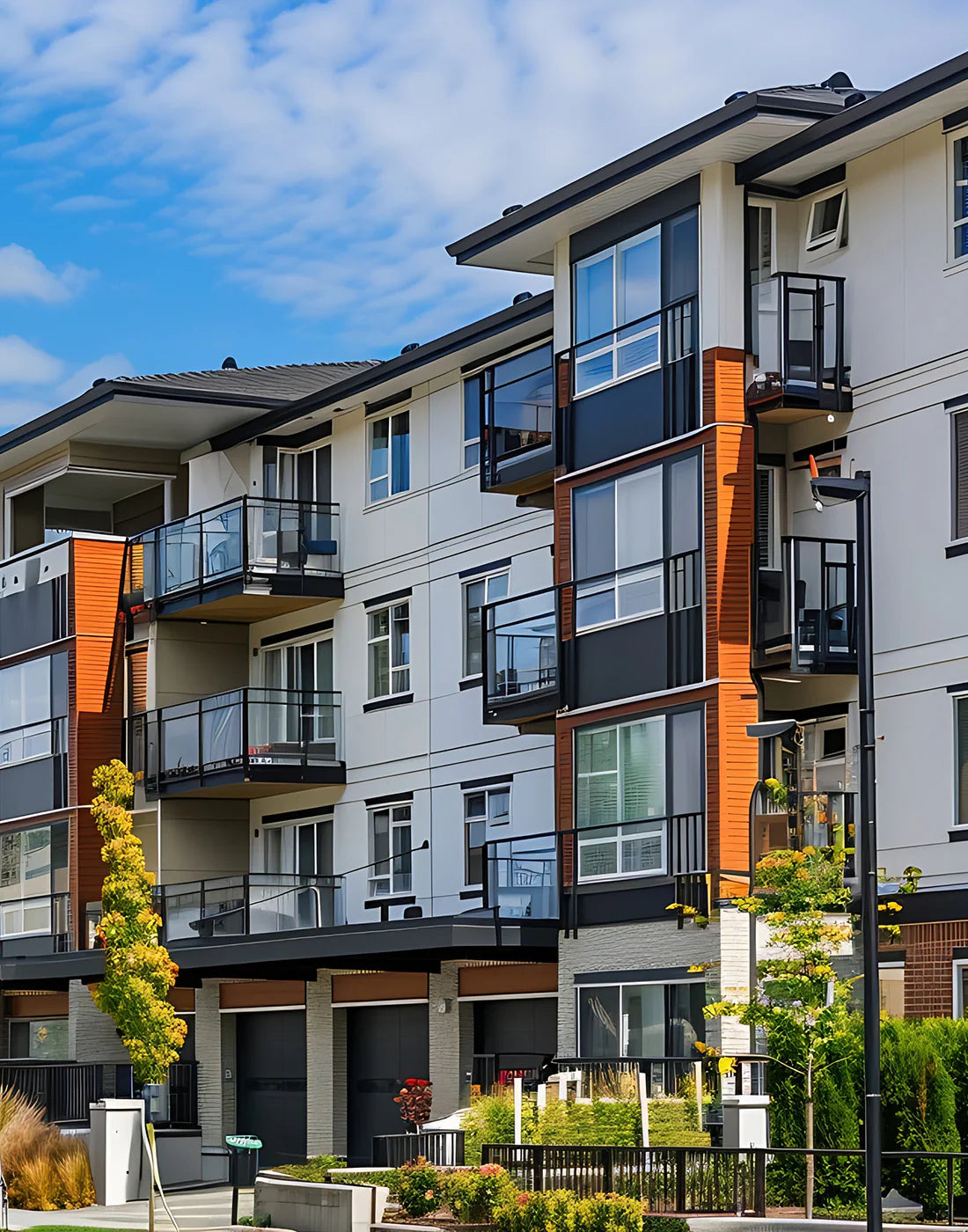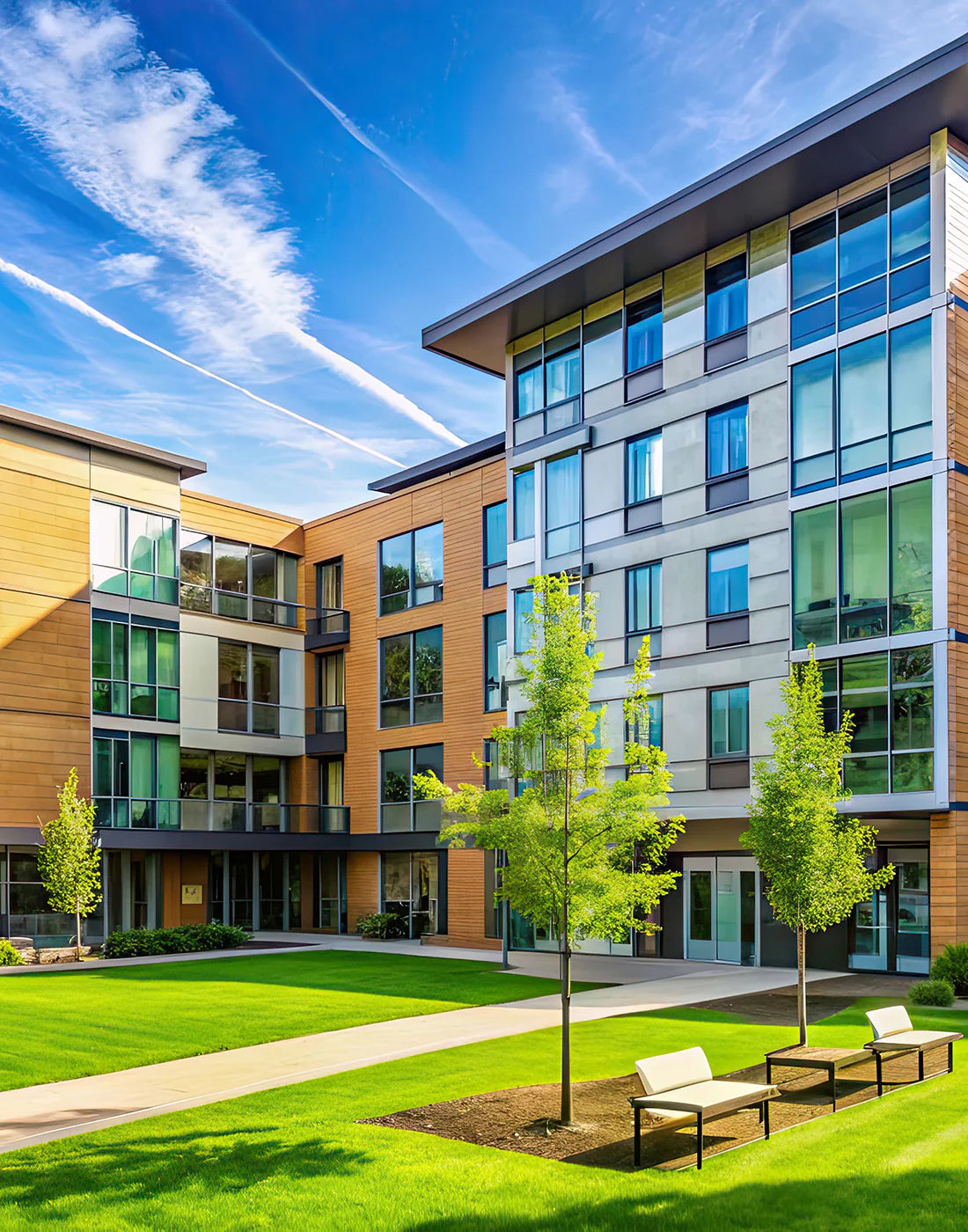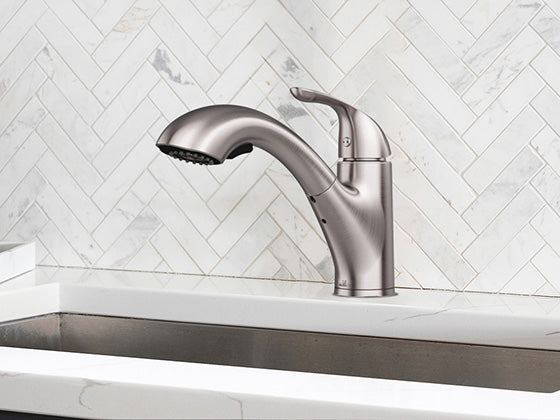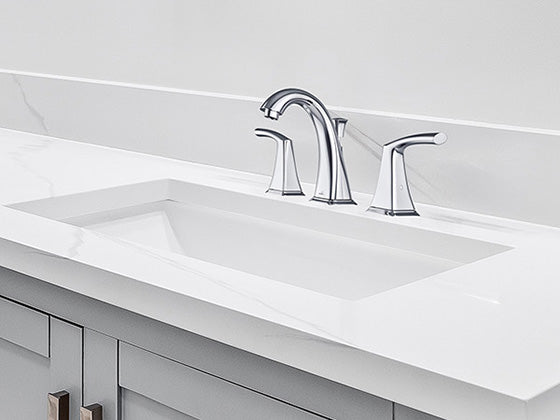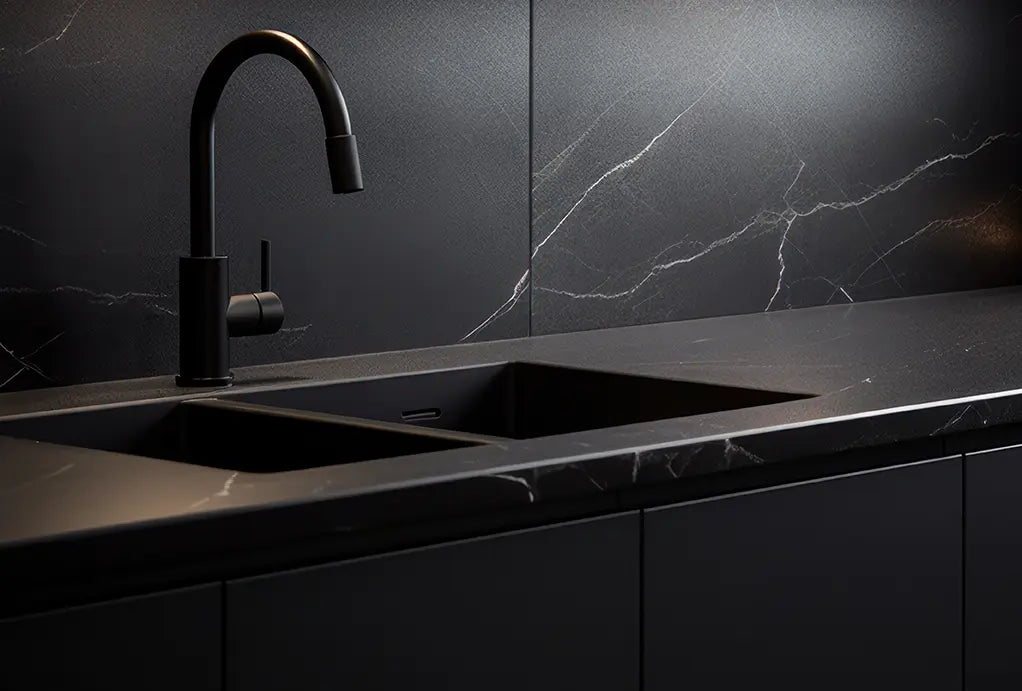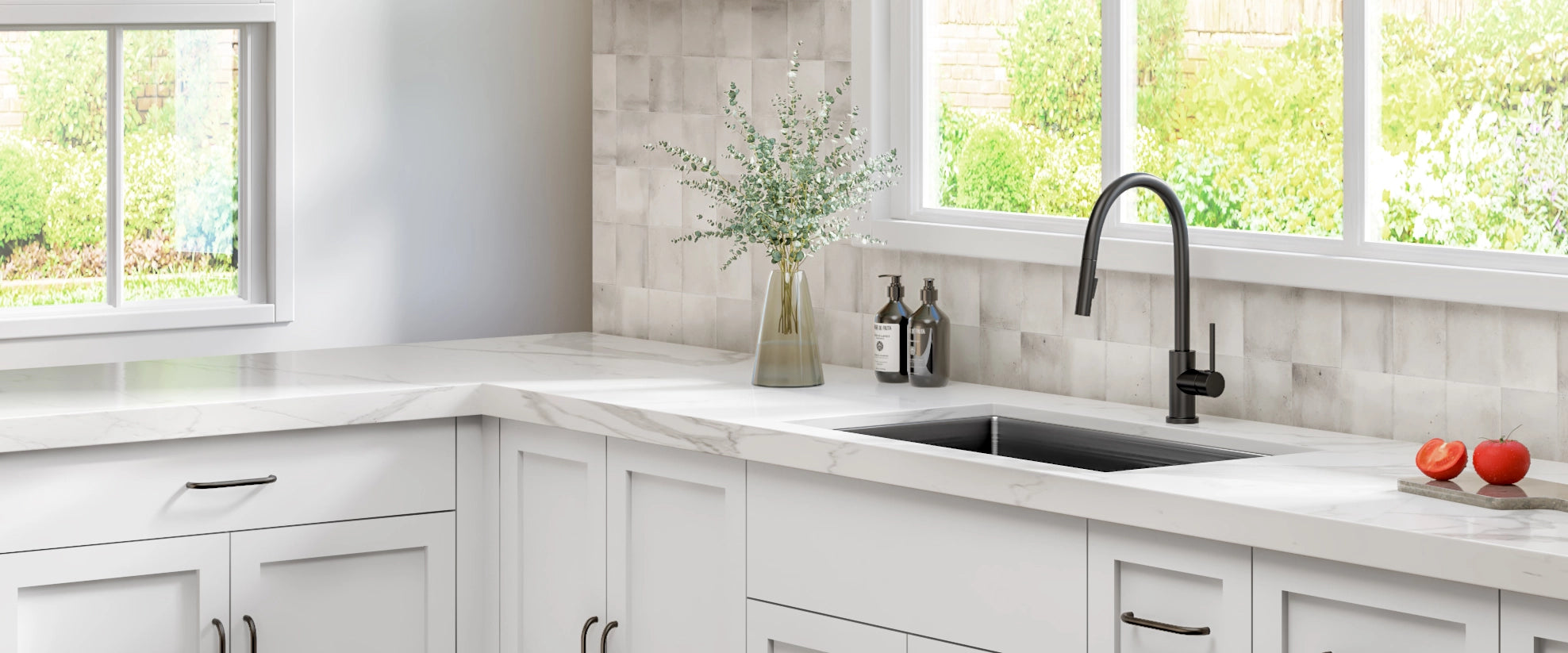Comprehensive Guide to PVD Sinks: How They’re Made, Durability Concerns, and the Future of Colored Sinks
To stay competitive in the multifamily residential industry, you need to stay on top of current styles. But it can be hard to know what’s a fleeting trend and what’s here to stay.
Newer materials in fixtures like kitchen sinks and faucets can keep your kitchen designs from looking dated. But they don’t have the proven lifespan or reliability of established materials like stainless steel or fireclay.
Isn’t it better to stick to the tried-and-true classics?
If PVD kitchen sinks have shown up on your radar, you may have a few questions before you’re ready to add them to your list.
This guide will tell you everything you need to know about PVD, like:
- Are PVD colored kitchen sinks affordable?
- Is PVD durable, and how long does it last?
- How are PVD kitchen sinks made?
- Do people like PVD kitchen sinks?
Let’s dive in.
Chapter 1: How Is a PVD Kitchen Sink Different from a Stainless Steel Sink?


First, what exactly is a PVD sink?
PVD stands for Physical Vapor Deposition. It’s a process for improving stainless steel sinks to make them stronger, more durable, and longer lasting. It can even make kitchen sinks easier to clean.
The main advantage is color coating that won’t scratch, peel, or flake. Meaning the sink is easier to maintain and won’t lose its looks with regular use. (More on the manufacturing process in Chapter 4!)
But how does uncoated stainless steel compare to stainless steel sinks with PVD?
Is PVD better than stainless steel?


As you can see, PVD has a lot going for it. But let’s dig into those perks to see why it appeals to residents, and why it’s great for builders, too.
Chapter 2: Why Residents and Homeowners Love PVD Sinks


You already saw the list of perks PVD brings to a stainless steel sink.
Let’s take a closer look at exactly why it appeals to residents and homebuyers and how to get the most out of a PVD sink in your next kitchen design.
2.1 Are PVD Kitchen Sinks Getting More Popular?
In short, yes.
PVD kitchen sinks are gaining popularity, and that trend shows no signs of slowing down. There are several good reasons for this.
- Residents want designs that stand out. Today’s residents and homebuyers want more variety in the colors of fixtures and finishes in their kitchens. And PVD is a perfect way to deliver.
PVD finishes have a sleek, modern look that adds a touch of luxury and unique appeal to any kitchen. (More on that in Chapter 2)
- Growing awareness and availability. PVD has been used in kitchen faucets for more than 30 years. As people become more aware of PVD as an option for kitchen sinks, its popularity continues to grow. As PVD kitchen sinks build a successful track record, more people are looking for it. Which means more manufacturers are making it available in their catalogs.
- It suits current design trends and is easy to color-match. Kitchen design trends in 2024 are all about customization and warmth. However, some sink materials can be difficult to match to cabinet hardware and faucets. Because of its wider range of options for colors and finishes, PVD is an ideal pick if you’re looking for a sink that’s easy to match to create a cohesive, coordinated kitchen.
2.2 What are the Most Popular Color Choices for PVD Kitchen Sinks?


The variety of colors is the number one reason many homeowners and residents become interested in PVD sinks. After all, a fixture’s color is often the first thing they’ll want to choose.
Each coating material has its own properties (more on that in Chapter 4) including color.
Here are the 5 most popular PVD sink colors.
- Matte Black is in highest demand for its modern, sleek appearance. It’s also a versatile option that complements a wide range of kitchen designs. Plus, matte black is easy to match to other fixtures and hardware and it blends easily with many color palettes.
Matte black has been popular in kitchen faucets for several years. Matching a black sink to a black faucet can bring eye-catching sophistication to modern, minimalist, and industrial kitchens.
It’s worth noting that granite composite is the current go-to option for matte black sinks. We’ll dig into a detailed comparison between the two in Chapter 3.
- Gunmetal Gray is next on our list. It’s versatile and contemporary, and has similar versatility to matte black. However, since gunmetal has a softer look, it’s not as stark or high-contrast.
That makes it a great choice if you’re looking for something a little warmer or more neutral than black. Gunmetal is easy to mix with brushed nickel or stainless steel faucets, and looks great with a wide range of countertop materials.
- Brushed Gold ranks very high on surveys for faucet colors, but is harder to incorporate as a basin color. It’s luxurious and opulent, but can overwhelm some aesthetics.
Gold PVD kitchen sinks are appealing to a specific audience looking for a particularly high-end look. However, for multifamily projects you may be better off with something a little more neutral.
- Rose Gold has a warm, delicate look that’s currently trendy. However, it’s not as universally appealing as other, more neutral colors.
Like brushed gold, rose gold may be a better option for custom projects. It can also be a great color to include on customization lists for suburban developments.
- Bronze is classic and warm, but tends to have more niche appeal than other finishes. It’s not as contemporary as other options, but looks great in traditional kitchen designs.
Color may be the first thing that gets a homeowner’s attention, but how do PVD sinks stand up to regular use?
2.3 Why Some Clients Hesitate: Durability Concerns and Maintenance for PVD Sinks


Because it’s newer than other materials, some people may worry about how durable PVD sinks are, and whether they’ll start to break down over time.
In part, these concerns stem from a misunderstanding of what PVD is. After all, when people hear “coating,” their mind may automatically jump to something that’s going to peel or wear out.
However, the PVD manufacturing process creates a microscopic bond between the finish and the base material. Basically, the coating becomes fused to the material, rather than being stuck on top of it. That means it’s impossible to remove without damaging the sink itself.
In fact, the surface of PVD kitchen sinks is up to 10x the hardness of hardened steel and more resistant to scratches and dents than uncoated steel.
So your clients can get a luxury sink that stands up to their busy lifestyle.
Some people hesitate to go with a colored kitchen sink because they have a reputation for needing lots of upkeep. But unlike copper or brass, cleaning a PVD-coated stainless steel sink is exactly the same as regular stainless steel.
In fact, they’re even easier to clean because the coating is extremely smooth, making it harder for dirt and grime to stick to the surface, and even preventing water spots.
That means washing a PVD sink is easier than uncoated stainless steel.
Like uncoated stainless, a PVD coating can be damaged by certain harsh chemicals and rough scrubbing with abrasive agents. However, under normal use they are much more durable than standard stainless steel sinks.
So PVD sinks look great, they’re easy to maintain, and they last. That makes them a win for residents.
But are they profitable investments for builders, designers, and installation teams?
Chapter 3: Why Is PVD a Great Choice for Builders?
As a builder, your priorities are different from your residents’.
You need fixtures that will keep your project running on time and within budget. So, how does PVD stack up for builders?
Let’s start by looking at how PVD can fit into your project’s budget.
3.1 How Does PVD Compare to Other Colored Sink Materials?


Colored sinks are nothing new, and there are plenty of options out there. So how does PVD stack up compared to other types of colored sinks?
3.2 Are PVD Kitchen Sinks Right for Your Project?
So what does all that mean for multifamily builds, specifically?
PVD strikes the perfect balance between luxury looks, and ease of transport. Your team won’t struggle to lug it around your worksite or risk breaking it during the install. And installing a PVD sink is much easier than heavier materials.
Plus, most stainless steel and PVD sinks can be stacked, saving space during shipping and keeping your worksite efficient.
It’s durable, with a great lifespan, and even the most choosy residents will love how it looks.
Relative to other colored sink options like brass, copper, and granite, it’s also relatively affordable. However, your budget may not have a lot of wiggle room, especially if you’re working on a large multifamily build.
For most multifamily building projects,uncoated stainless steel still offers the most bang for buck.
But PVD can give your luxury apartments, high-end condos, or suburban development projects a major edge over the competition. So it’s an ideal option to deliver the unique luxury look most high-end residents want.
That makes it a clear front-runner if you’re looking for the best colored sinks for multifamily residential builds.
So we can see why it’s a favorite for residents and builders alike.
But how are PVD sinks made? What is the manufacturing process, and what types of finishes can you find?
Chapter 4: How Is a PVD Sink Made?
There are three main components to creating a PVD coated kitchen sink: the base, the coating, and the process.
Let’s look at each of those one at a time.
4.1 What Base Materials Are Used for PVD Coated Kitchen Fixtures?
The PVD process is amazingly versatile. It can add coatings to everything from glass to nylon and ceramic.
In kitchen faucets, PVD coatings are frequently added to bases of stainless steel, brass, copper, zinc, and plastic.
For kitchen sinks, stainless steel is the most common base for PVD.
As we already saw, stainless steel is already corrosion-resistant, durable, and strong. The PVD process takes all those great properties of an excellent material and takes them to the next level.
It enhances the aesthetic appeal, lifespan, and easy maintenance stainless steel already offers.
That’s not to say it’s the only base. We may see PVD added to many types of sink bases in the future. But for now, the vast majority of PVD sinks have a stainless steel base.
Next, let’s look at what materials are used for PVD coatings.
4.2 PVD Coating Materials - What Are They, and Which Is Best?
There are many compounds and materials that can be used to create a PVD coating. Many are metals or contain metal components, but not all.
Each material brings its own unique properties and colors to the kitchen sink. So how do you know which materials are best?
Here are a few of our top picks.
- Titanium Nitride (TiN).
Durability: Extremely high
How it looks : Gold finish, luxurious and modern look
Resistance: Excellent resistance to scratches, wear, and corrosion
Lifespan: 20+ years
Advantages: Striking gold finish that is both stylish and highly resistant to wear and tear.
Best for: A long-lasting, luxurious appearance.
- Zirconium Nitride (ZrN)
Durability: Very high
How it looks: Gold or champagne finish, elegant and sophisticated
Resistance: High resistance to corrosion, wear, and scratches
Lifespan: 20+ years
Advantages: Similar durability to Titanium Nitride but with a slightly different shade of gold, often appearing more champagne-like.
Best for: Durability and a unique color.
- Chromium Nitride (CrN)
Durability: High
How it looks: Silver or metallic finish, sleek and modern
Resistance: Excellent resistance to corrosion and moderate resistance to scratches
Lifespan: 15-20 years
Advantages: Sleek, modern metallic look with excellent corrosion resistance.
Best for: A durable silver finish that complements a variety of kitchen styles.
- Titanium Aluminum Nitride (TiAlN)
Durability: Very high
How it looks: Dark gray to black finish, modern and sophisticated
Resistance: Superior resistance to heat, wear, and corrosion
Lifespan: 20+ years
Advantages: High heat resistance and extreme durability.
Best for: A contemporary touch that elevates any kitchen.
- Carbon-Based Coatings:
Durability: Extremely high
How it looks: Black finish, sleek and elegant
Resistance: Exceptional resistance to scratches, wear, and corrosion
Lifespan: 20+ years
Advantages: Incredibly hard and durable, providing superior resistance to scratches and wear; low friction, making a sink easy to keep clean and preventing bacterial buildup.
Best for: An elegant and highly functional focal point in modern kitchen designs.
Your coating selection will largely depend on what color sink you’re looking for. Even from one gold finish to another, there are variations in each material’s tone that will make it more or less appropriate for a specific kitchen design.
Now we know what our base and coating materials may be. But what does the PVD process entail?
4.3 The PVD Coating Process
Before applying the coating, the base will be thoroughly cleaned to remove contaminants. Usually, that includes ultrasonic cleaning, polishing, and completely drying.
The basin is then placed into the vacuum chamber. The high vacuum removes air and contaminants, creating an ideal environment for the coating process.
In many cases, the sink will also be etched with a high-energy argon plasma inside the chamber. This roughens the surface, improving mechanical retention of the coating.
The coating material is then vaporized using one of several methods such as:
- Cathodic arc - an electric arc vaporizes the coating material
- Sputtering - ions are accelerated at the material, ejecting atoms
- Evaporation - the material is heated until it vaporizes
With the coating turned into a vapor, manufacturers can then deposit it onto the sink surface. This happens by applying high voltage to the parts, which draws the vaporized material onto the sink.
From there, small amounts of nitrogen, oxygen, or carbon-containing gasses are added to the chamber. These gasses combine with the vaporized metal to create a new compound material with the colors and functional characteristics we want to create.
After that, the chamber is cooled and brought back to atmospheric pressure.
4.4 Is PVD an Eco-Friendly Process?


To stay competitive in today’s home building market, it’s worth leaning into environmental considerations like LEED certification.
Today’s residents and homeowners are more aware than ever of the environmental impact their home may have. They care about choosing the right materials to minimize the negative impact their home may have on the environment.
They’re also concerned about materials that could harm their health with exposure over time.
So, is PVD eco-friendly, and is it safe?
In short, yes. The PVD process is a highly efficient process that eliminates many potentially harmful materials that are used in other manufacturing processes.
- Reduced Volatile Organic Compounds (VOCs): PVD is a dry and vacuum-based process that eliminates the use of liquid solvents and the associated VOC emissions. This results in improved air quality and a safer working environment, minimizing health risks for workers. It also reduces pollution output overall.
- Minimal Waste: The PVD process generates very minimal waste and has no environmentally dangerous by-products. This reduces the environmental footprint of the manufacturing process and eliminates the need for costly waste management systems.
- Energy Efficiency: PVD coating manufacturing can be highly energy-efficient due to the controlled vacuum environment, which allows for precise deposition. Optimized energy use in the PVD process leads to significant energy savings compared to traditional coating methods.
- Extended Product Lifespan: PVD coatings can provide enhanced wear and corrosion resistance, extending the lifespan of coated products. Longer-lasting products reduce the need for frequent replacements, conserving resources and reducing overall material consumption.
- Elimination of Hazardous Chemicals: PVD does not involve the use of hazardous chemicals, acids, or pigments in its process. This reduces the risk of environmental contamination and ensures compliance with environmental regulations, creating a safer and more sustainable manufacturing process.
- Worker Safety: By avoiding the use of caustic chemicals and hazardous materials, PVD processes create a safer working environment for employees. This reduces health risks and potential accidents.
So not only is PVD a selling point from a design and use standpoint. It also has great potential appeal in terms of the manufacturing process itself.
As you can see, PVD’s growing popularity is well-earned. The process is predictable, efficient, and only getting better.
So what does the future hold for PVD kitchen sinks?
Chapter 5: Future Trends in PVD
As with any new technology, the PVD process has improved over time. And it shows no signs of slowing down.
Future trends in PVD will probably include the following types of improvements:
- Materials will get more advanced. New materials like nanocomposites already show a lot of potential in enhancing the hardness, wear resistance, and thermal stability of PVD coatings.
- It will get more affordable. As technology keeps improving, the process gets more efficient. AI integration, real-time monitoring, and predictive maintenance will all help to decrease costs without compromising quality.
- It will get even more eco-friendly. Continued improvements in energy efficiency and more availability of non-hazardous materials will make this already environmentally-friendly option even better.
- Aesthetics will continue to improve. PVD sinks already offer a wide range of colors and textures. Improvements on the process will expand those options to meet diverse tastes and design preferences.
- PVD sinks will get even more durable. Future advancements will further improve the anti-scratch, anti-corrosion, and anti-bacterial properties of PVD kitchen sinks.
In short, PVD is here to stay. And as it becomes more affordable, more available, and more customizable, your clients are going to start asking about it.
The best way to stay ahead of the curve? Partner with a wholesaler at the leading edge of this industry-disrupting manufacturing process.
Chapter 6: Giving Your Clients the Best in PVD Sinks
Hopefully this guide has helped you understand the ins and outs of PVD kitchen sinks. Now that you understand what it is, how it’s made, and why your clients will love it, all that’s left to do is find the right wholesaler to connect you with affordable PVD sinks.
High-caliber manufacturing with quality materials is the best way to ensure your clients get eye-catching fixtures that last.
That’s where Allora USA can help!
We offer guaranteed stock, so you know you can get what you need on time without worrying about supply chain issues. Plus, our warranties and money-back guarantee ensure you’ll get the perfect fit for your design and lasting quality for your clients.
We specialize in professional support for builders, designers, and purchasing managers for multifamily projects. We’ve got options to suit every budget and design.
To make things even easier, we provide standard and ADA options in one convenient place. Buying ADA fixtures from a reputable manufacturer means getting products that meet regulatory and quality standards.
Plus we offer:
- Discounts for commercial projects.
- Guaranteed pricing.
- Product warranties.
- Fast customer support
- Free shipping to most areas in the US.
- Delivery within 5 days or less anywhere in the US.
- Unlimited phone and email support.
Ready to get started?
You can filter through a variety of colored sink options on our site. You can even hone your search with specifics like what finish, basin size, or style you’re looking for. Or look through our catalog for a full list of options and alternatives.
Or, send us your specs and we’ll put together a list of options that will fit your project. We can set you up for ongoing care for all your builds, so you can get great fixtures every time without wasting hours searching for what you need.
Chapter 7: F.A.Q.
Are PVD Kitchen Sinks Affordable?
While they’re more expensive than uncoated stainless steel sinks, PVD kitchen sinks are at the lower end of the price range for colored kitchen sinks.
How Can a PVD-Coated Stainless Steel Sink Boost Your Project’s Profitability?
High-quality colored kitchen sinks add luxury and opulence to any kitchen design. In turn, luxury fixtures and attractive kitchens increase your project’s value per square foot. PVD is an excellent option for creating updated kitchens that are on-trend and appealing to residents and buyers with bigger budgets.
Are PVD Sinks Durable?
Yes. PVD coatings improve the already notable durability of stainless steel sinks. The coating enhances stainless steel’s resistance to corrosion, scratches, and discoloration? In fact, PVD coatings can even prevent dents.
What Makes PVD Coating on Sinks So Effective?
It comes down to the manufacturing process. PVD coating bonds to the substrate at the microscopic level, and is impossible to remove without damaging the sink itself. This results in a thin, yet extremely hard and durable coating that integrates with the sink’s surface.
Can PVD Be Scratched? Can Scratches on a PVD Sink Be Fixed?
Contrary to misconceptions about PVD, it is highly resistant to scratches and stands up well to daily use. In the extremely unlikely event that a PVD sink gets scratched, the coating can’t be polished or repaired without stripping and recoating the sink.
How Can Manufacturing Processes Increase PVD Sink Longevity?
After the PVD coating process, a microscopic sanding step can be applied. This technique smooths out any imperfections and gently “scuffs” the top surface, which helps to reduce the risk of scratches. The result is a smoother, more resilient surface that can withstand everyday use.
Another effective method is to apply the PVD coating to an already-textured, embossed stainless steel surface. This approach increases the overall durability of the sink and greatly reduces the chances of scratching. The textured surface provides an extra layer of protection, making the sink more resistant to the wear and tear of daily life.
How Do You Clean a PVD Sink?
Like stainless steel, a PVD sink just needs to be washed with mild dish soap and a soft sponge or microfiber cloth. In fact, many types of PVD coating are lower friction than uncoated stainless, meaning debris will not stick as easily. That makes PVD sinks antimicrobial and easier to keep clean than other materials.
Are There Special Instructions for PVD Sink Installation?
Installing a PVD coated kitchen sink is generally the same as any other sink in a similar design. Except that it’s easier than with heavier materials like fireclay. That makes it an excellent choice for streamlining workflow on your construction site and keeping your project running on time.





